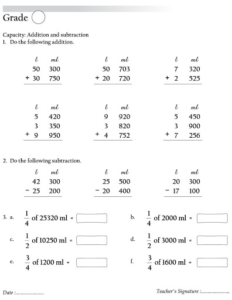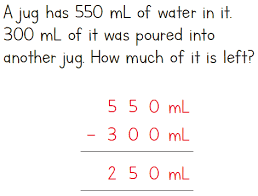Back to: Mathematics Primary 6
HELLO, WELCOME BACK TO CLASS
Capacity is the maximum quantity that a container can hold or that something can produce. For instance, a glass has a capacity of 300 ml (but is actually holding only 160 ml). Capacity is measured in milliliters (ml) or liters (l) in Metric, or pints and gallons in Imperial.
1ml = 1cm3
1000cm3 = 1 litre = 1000ml
I liter of water weight 1kg
10ml of water weight 1000g
1000cm3 of water weighs 1kg
Addition and Subtraction of Capacity


- A water tank contains 2225 litres of water. During the day 975 l 325 ml of water is pumped out from the tank. How much water is left in the tank?
- A milkman sold 55 l 575 ml of milk on the first day, 40 l 480 ml on the second day and 60 l 825 ml on the third day. What quantity of milk did he sell during these three days?
Multiplication and Division of Capacity

- A Dettol bottle contains 500 ml of Dettol. How much Dettol is contained in 12 dozen such bottles?
- A drum contains 12 litres 156 ml of varnish. It is supplied to 12 shops equally. How much varnish does each shop get?
- Express the following in ‘ml’
(i) 19 l
(ii) 21 l 75 ml
(iii) 28 l 350 ml
- Convert the following into litres and millilitres.
(i) 75000 ml
(ii) 9485 ml
(iii) 23456 ml
